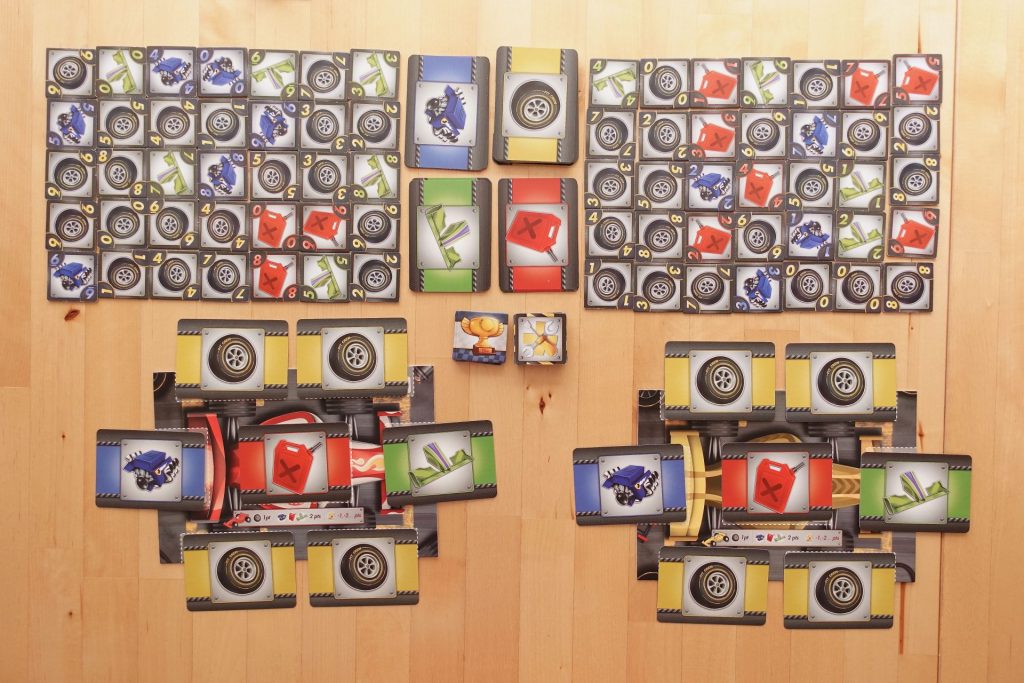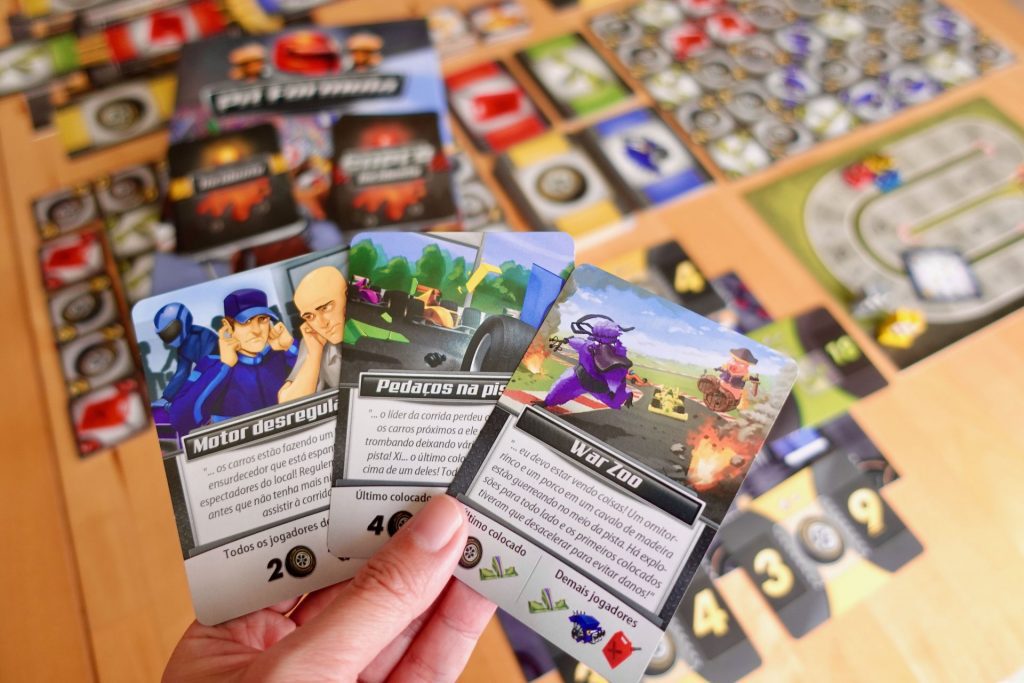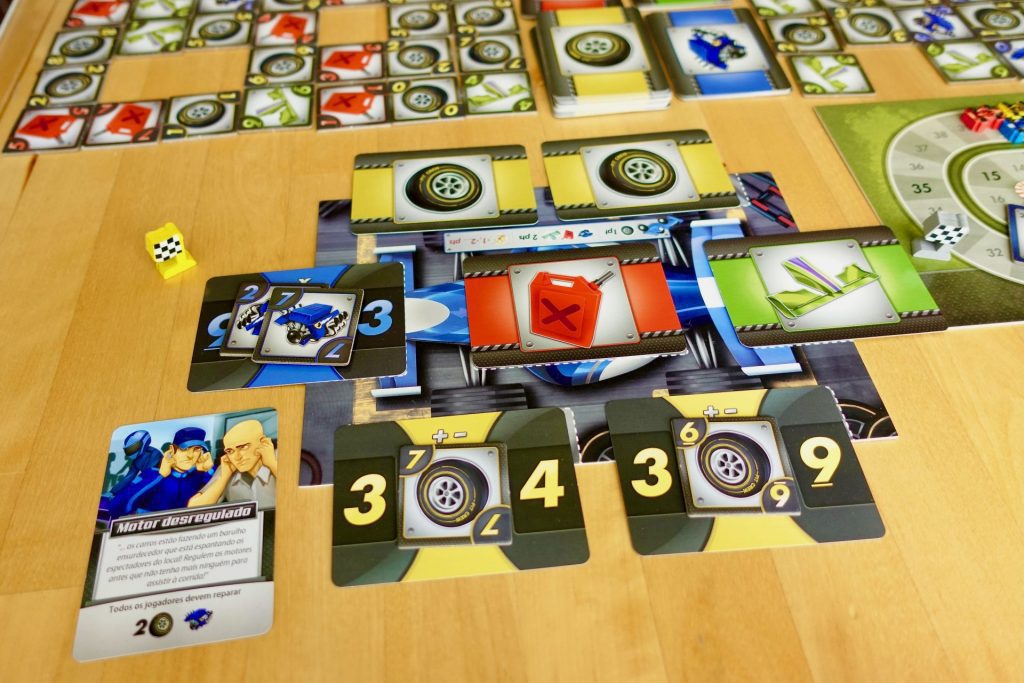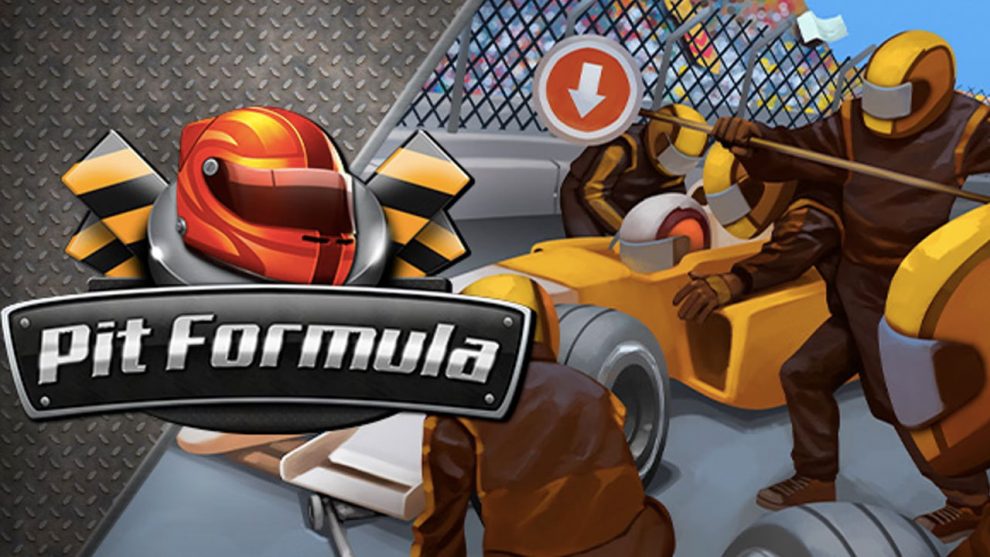Introduction
Even in the midst of Covid in 2021, the Ferrari Pit Crew practiced more than 1300 pit stops between April and December—a sign of dedication to their work, to the team, and their desire to get it perfect during race day. I want my car crazy kids to know that greatness comes with hours of work especially when it comes to math practice!
The Prix
Pit Formula is a frenetic card game that requires concentration and quick thinking to be the fastest pit crew to solve your race car’s issues in order to win the race! Different car parts are repaired by different math operations: addition, subtraction, multiplication or numeric intervals, as players simultaneously solve these math problems and find the missing parts to fix their car.
Formation Lap
The game is set up like so:

Each player receives a Player Car Mat and a Car Marker. The number tokens are set up in 2 random arrays of 7 by 5 and placed within easy reach of all players. These are the tokens that will be used to replace faulty parts throughout the game. The stack of 12 Spare Part tokens should also be placed in close proximity.
Lay out the cards according to the different parts; Tires, Wings, Gas and Engine, as well as the Crash cards that will be used to determine which parts need to be replaced. Draw 5 random Trophy tokens to be used at the end of each round, which determine point values scored for each race.
The Racing Scoreboard is laid to the side with Car Markers placed at the start position. Depending on the number of players, the Flag Markers that indicate 1st, 2nd and 3rd placements should be within arm’s reach. Each game utilizes 1 less Flag Position token than the number of players, so a 4 player game will only have 3 Flag tokens and a 3 player game will only have 2 Flag tokens. Lastly, each player draws cards to complete their Player Mat with the corresponding car parts.
3 – 2 – 1 – GO!

In each round, a player draws a Crash card that shows which parts have issues and must be resolved. Most cards indicate for all players to replace the same parts, although some may activate a catch-up mechanism, requiring the leader or the last placing player to replace parts different from the rest of the players. After the card is read aloud and the parts to be replaced identified, the card is laid visible to all players. On the count of 3, everyone starts resolving their problem cards as fast as possible using Part tokens from the number array.
The Tire cards are resolved by finding the sum or difference of the two numbers. Wing cards are repaired with two tokens that make up the sum or difference of the 2 two-digit numbers. Engine cards need to be fixed by finding the product of the two numbers and Gas cards are resolved by completing the interval between the two numbers found on the card.
In the event that a number token is unavailable because it has already been used, a player may use a Spare Part token as a Wild to replace it. However, points will be deducted at the end of the turn so use them sparingly!
When players have completed repairing all the required parts, they may choose to either grab their Flag position Markers or continue replacing other parts of their car for bonus points awarded at the end of the round.

Once all the Flag position markers have been claimed, it is time to score the race. Make sure to check to see that all players have accurately replaced their car parts. Errors will result in the Flag Tokens passed onward to the next player after, so you could lose pole position for a careless mistake!
The player holding the 1st place Flag token draws a Trophy token which indicates how many points are awarded to players for their different positions. Only players with flag markers receive Trophy points. Points are also awarded for each correctly repaired part: 1 point for each Tire and 2 points for each Gas, Wing, or Engine card including any extras they completed. Any Spare Part token used will also deduct points. The Trophy token is then kept by the 1st player to be used in the case of a tie.
To start the next race, reset the playing area; all tokens are placed back in the 7 by 5 array, car parts replaced on the playing mat and Flag position markers returned to the center of the table. The winner of the previous race starts the next round by drawing another Crash card and starts a new race. After 5 races, the player with the most points is declared the winner. In the event of a tie, the player with the most Trophy tokens wins.

For my youngest, who has not started on multiplication yet, we removed the Engine tokens and cards, and the corresponding Crash cards that required fixing the Engine cards. With the older kids who needed more time for multiplication, we kept those cards in play but would give them the advantage of an undercut to get ahead. We jump started their race by solving the multiplication problems before the rest of the players started, as a handicap to the older ones who were more fluent with the operation.
The Last Lap
My car crazy six-year old has been a big fan of Pit Formula since we got it. Unlike other race-around-the-track games, and believe me we have many, this game has players taking on the role of the Pit Crew, an extremely vital role in all Prix races! Breaking down the Formula race car to its parts: tires, wings and engine also adds a fresh angle to racing.
The part that got her most excited was drawing fresh Crash cards at the start of each of the races. The card text made for an imaginative world where she could suspend reality and put herself on the race track. In fact, that appeal to find out what could go wrong and what needed to be fixed, had her playing for more than the suggested number of rounds! And I am not going to stop her practicing more math that way! The points awarded at the end of each round and totaled at the end of 5 races also lent itself towards the verisimilitude of the Drivers’ Championship leaderboard in formula Prix racing.

The game, like an actual pit stop, can look like chaos to the unacquainted eye. It all comes down to the basic operations of math, which makes this game perfect for kids who love racing themes to get more math practice whilst having lots of fun. I will admit, we stacked the odds of this game in our favor by watching a few Indy car races and a couple of YouTube videos on how Pit crews are trained to maximize the immersive nature of the game.
The game, like the Prix, has a fast turnaround before the checkered flag drops. This helps players keep their pedal to the metal before they lose steam with all the thinking required. My only complaint is the use of the token arrays to resolve each card’s math problem. Having to look across 70 tokens over the table for the one piece that you need comes down to visual acuity and dexterity. This is a disadvantage for players on either side of the age spectrum. That said, whilst watching the video on Pit Crew training, they did mention that those were the exact skills required to be a successful member: quick thinking, visual focus, cognitive awareness and hand-eye coordination. So, I suppose it is all in keeping with the theme.
The Checkered Flag
If you’ve ever watched any car race with pit stops, you’ll know they make it look SO easy. Those teams put in hours to make it look that smooth. Pit Formula is an exciting game to encourage learners to keep practicing more math until it is just as effortless for them—then they can lap the rest of us!











Add Comment